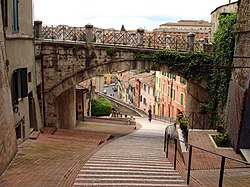Assunta Pieralli
Assunta Pieralli (1807 – 31 October 1865) was an Italian poet and teacher who actively supported the Italian unification movement known as the Risorgimento. LifeShe was born in Lippiano, in the province of Perugia, Italy, to Giuseppe Pieralli and Francesca Capacci, who were well off financially. She had three brothers.[1] EducationHer education began in her family's library with the help of some friends of her brother Ottavio, a parish priest in the nearby village of San Giuliana. They gave her lessons in Latin.[1] Later, Antonio Lignani, an educated man who had proposed the cathedral of Città di Castello, discovered Pieralli's talents and introduced her to the academic environment. Then, as an adult, she met two other accomplished men who significantly influenced her education: Antonio Mezzanotte, an antiquarian and classicist, and Averardo Montesperelli, who taught her French.[1] RisorgimentoPierelli became well known for her "patriotic poetry"[2] in support of the Risorgimento, the multi-decade Italian revolutionary movement that, in 1871, finally united the many separate states on the Italian Peninsula into a single Kingdom of Italy. Her goal, and that of other published women of her time, was "to form a new class of young, educated and politically committed women."[3] Her dedication to the cause was complete, according to Treccani,
Governess According to Tortorelli, Carlo Emanuele II of Sorbello and his wife Ginevra Ramirez di Montalvo engaged Pieralli to be governess to his three daughters, Altavilla, Ludovica and Cecilia, and she proved to be exceptional at the task. Sorbello was known to appreciate Pieralli's political awareness, grand temperament, intelligence and modern views for the Risorgimento.[1][4] According to Treccani,
TeacherIn 1861, she was asked to teach history and geography at the normal female school of Perugia, set up by the unitary government and then directed by Giovanni Pennacchi.[1] Pieralli's name appears today on the Institute of Higher Education “Assunta Pieralli” in Perugia,[5] She died there on 31 October 1865. References
|
||||||||||||||













